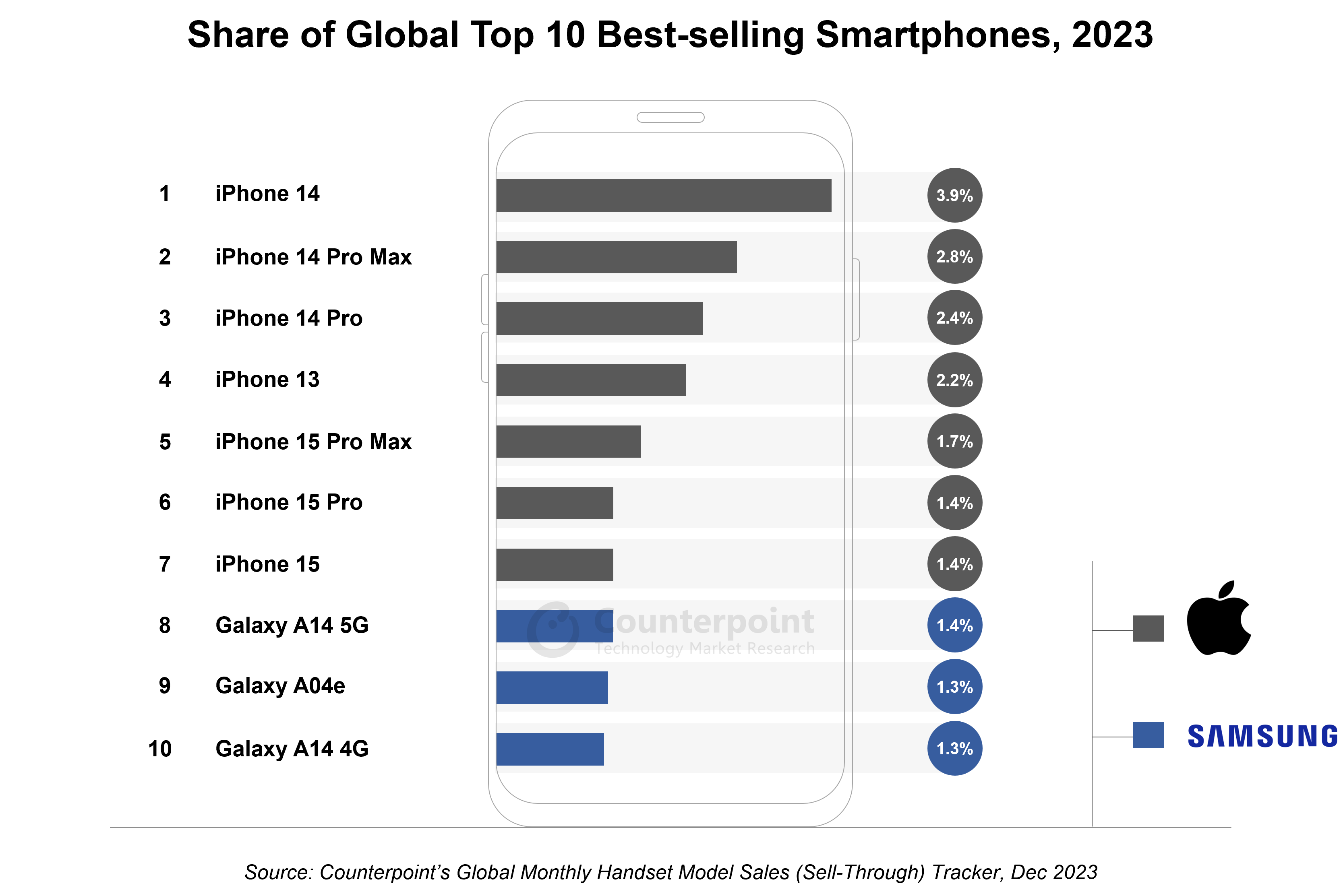What is Brand Positioning? Types, Examples and More
Is Brand Positioning another buzzword?
Let’s take the example of Apple. Even though there are good Android phones in the market, which are newer cheaper and richer in terms of features, apple still has a huge fan following. As per Counterpoint Research, the top 10 list is still dominated by Apple.

Do you know why?
The answer is Brand Positioning.
But what is brand positioning?
Essentially brand positioning is a symbolic “space” in the hearts and minds of customers. For example, Apple carved out a distinct identity for the iPhone. It wasn’t just a communication device, it was a seamlessly integrated experience tailored for modern life. Apple’s brand positioning was based on 3 key elements: innovation, design and customer experience.
Here’s another example:
Dollar Shave Club offered high-quality blades at affordable prices delivered directly to customers, disrupting the traditional market. This positioning resulted from their market research which revealed the dissatisfaction with overpriced razors and inconvenient subscriptions.
The result? Dollar Shave Club rapidly grew, ultimately selling for $1 billion to Unilever, showcasing the power of addressing unmet customer needs.
These are just a few examples, and the key takeaway is that successful brand positioning relies on understanding your target audience and their needs using data. Analyze market research, customer feedback, and relevant data points to gain insights that differentiate your brand.Brand positioning essentially provides core direction for branding, shapes product decisions, fuels go-to-market strategies, and sets us apart from the competition.
Types of Brand Positioning Strategies
There are several key types of positioning strategies brands can leverage. The approach (or hybrid approach) you choose depends on your specific industry landscape, business goals, target buyer persona, and unique strengths/advantages.
Let’s explore the types of positioning strategies in depth:
Benefit Positioning
One of the most straightforward positioning routes is to focus on the key benefit(s) your product or service provides customers.
For decades, FedEx has positioned itself around the key benefit of fast, reliable overnight/express delivery services. Its iconic slogan and positioning statement is:
“FedEx: When it absolutely, positively has to be there overnight.”
This positioning zeroes in on the core benefit FedEx provides – the ability to quickly and dependably ship parcels, documents, etc. literally overnight to virtually anywhere.
Competitor Positioning
Another common approach is to directly position your brand in relation (and in contrast) to your competitors’ perceived strengths and weaknesses.
The classic case study is Avis’s “When you’re only No. 2, you try harder” campaign from the 1960s. By acknowledging Hertz’s bigger market share, Avis was able to reframe the situation by positioning themselves as the rental car company that tries harder and delivers superior customer service.
Price or Value Positioning
A price-based positioning can work well for brands operating in extremely cost-conscious markets.
Walmart solidified its brand positioning by embracing the “low price leader” mantra with its “Save Money. Live Better” slogan.
On the flip side, premium brands like Apple have succeeded by positioning themselves as high-end, aspirational purchases aligned with innovation and luxury cachet.
User or Persona Positioning
Rather than product attributes or price points, some brands find more success in positioning themselves based on a specific user, demographic segment, or buyer persona.
Axe’s “Young Male” User Positioning Axe (marketed as Lynx in some countries) has firmly positioned its brand of men’s grooming products like body sprays, deodorants, and styling products toward the young, adolescent male persona.
Axe’s marketing overtly targets teenage boys and young adult men by tapping into the aspirations and insecurities around attracting romantic partners that are so prevalent in this life stage.
Product Category or Solution Positioning
Iconic brands sometimes aim to fully own and personify a particular product category, becoming the quintessential example that first comes to mind.
As mentioned earlier, FedEx has positioned itself as the quintessential solution for express/overnight delivery needs through its iconic “When it absolutely, positively has to be there overnight” positioning.
By owning the “overnight delivery” space in consumers’ minds, FedEx has an easier path to being the default choice when speed and reliability are paramount for shipping requirements. Its name is synonymous with that particular solution.
Emotional or Aspirational Positioning
While very tangible product attributes and use cases still hold importance, some of the most powerful brand positionings are based on emotionally resonant or aspirational qualities.
Nike has built an incredibly powerful brand positioning around inspirational emotions and the aspirations of athletes and fitness enthusiasts globally.
Instead of just focusing on the technical features of its shoes and apparel, Nike’s brand positioning taps into much deeper, motivational sentiments of drive, determination, and pushing human potential.
The brand’s famous “Just Do It” tagline and marketing campaigns aren’t just slogans – they embody an entire mindset and attitude. One of grit, perseverance, and daring to overcome limits.
Brand Positioning By Unique Selling Proposition (USP)
Popularized by Rosser Reeves in the 1940s, the USP model positions a brand based on its unique, compelling benefit that differentiates it from competitors. It aligns around single-minded positioning statements like “Fedex: When it absolutely, positively has to be there overnight.”
Head & Shoulders has positioned itself around the core unique selling proposition of being the best solution for fighting dandruff and providing anti-dandruff protection.
The brand’s taglines like “You never get a second chance to make a first impression” and “Flakes. You’re better off without them” laser in on highlighting dandruff as the key haircare problem it solves.
Value Discipline Model
As per this model by Michael Treacy and Fred Wiersema, brands position themselves based on one of three “value disciplines”: operational excellence, product leadership, or customer intimacy. It argues brands can’t excel at all three, so must prioritize one positioning.
There isn’t a single, universally agreed-upon example of a company perfectly embodying a single Value Discipline from the Treacy and Wiersema model, there are strong contenders that showcase specific aspects of each discipline. Here are a few popular examples:
- Operational Excellence:
- Amazon: Renowned for its efficient supply chain, automation, and focus on low prices and fast delivery, Amazon exemplifies operational excellence. They prioritize streamlining processes, offering a wide selection of products, and delivering them at competitive costs.
- Product Leadership:
- Apple: Apple consistently pushes boundaries in product design, innovation, and user experience. They prioritize creating sleek, user-friendly devices with cutting-edge features, even if it means a higher price point.
- Customer Intimacy:
- Ritz-Carlton: This luxury hotel chain emphasizes building close relationships with guests, anticipating their needs, and providing personalized service. Their focus is on exceeding expectations and creating a unique, memorable experience.
How to Create a Brand Positioning Strategy?
Creating that positioning strategy is both an art and a science. It requires a combination of insightful market research, understanding your target audience’s needs/motivations, analyzing the competitive landscape, and creatively defining your brand’s distinct promise.
Here’s a step-by-step process for developing a brand positioning strategy that will make your company truly stand out
- Conduct Thorough Market Research
The first step is to invest in comprehensive market research to gain a deep understanding of the industry landscape, consumer trends/needs, competitors’ positioning efforts, and any uncontested market territory. Gather quantitative data through surveys and analytics, but also seek out qualitative customer insights through interviews, focus groups, etc. - Analyze Your Competitors’ Positioning
Examine how other brands in your category are currently positioning themselves. Look for gaps or opportunities to differentiate based on product/service attributes, price positioning, target personas, category ownership, emotional/aspirational angles, and more. This analysis will help determine the best “open” positioning territory to claim. - Define Your Target Audience and Unique Value
Get crystal clear on who your ideal target customer is by building robust buyer personas. What are their core needs, pain points, motivations, and buying factors? How do you uniquely solve for them in a way competitors don’t? Distill your brand’s unique value proposition and differentiators - Explore Different Positioning Angles
There are many potential positioning strategy angles to consider (product benefits, pricing, user personas, category leadership, emotions/aspirations). Ideate and play around with different possible positions for your brand that align with your target audience’s insights and unique strengths. - Test Positioning Concepts
Once you’ve defined some promising positioning concepts, it’s crucial to pressure test them with your actual customers/prospects. Validate whether the positioning strategy truly resonates and differentiates you from competitors in their minds. Iterate based on feedback. - Craft Your Positioning Statement
Next, bring it all together into a concise, meaningful positioning statement (1-2 sentences) that encapsulates your own brand positioning. This will serve as the guiding light for all marketing and growth efforts moving forward. - Integrate Positioning Into Your Brand Identity
Finally, ensure your visuals (logo, design, packaging), tone and messaging, and all consumer touchpoints authentically and consistently reinforce your brand’s positioning in every single expression. Brand consistency is key.
Defining a powerful, ownable brand positioning is an intensive process, but it is necessary for differentiating in today’s crowded market. Get it right, and you’ll be able to create powerful, lasting connections with your ideal customers.
Some Brand Positioning Frameworks
1. Brand Value Map:
- Focus: Understanding your brand’s core values and positioning them against competitors.
- Components: A two-dimensional map plotting competitors on one axis and values on the other. Analyze where your brand falls and identify gaps for differentiation.
- Suitable for: Identifying your unique value proposition and competitive landscape.
2. Perceptual Map:
- Focus: Identifying how consumers perceive your brand and competitors.
- Components: Similar to the Brand Value Map, but axes represent attributes relevant to your industry (e.g., price, quality). Plot brands based on customer perception.
- Suitable for: Identifying areas for improvement based on how customers see your brand compared to competitors.
3. Brand Essence Chart:
- Focus: Defining the core essence of your brand and its personality.
- Components: A chart with axes representing contrasting qualities (e.g., traditional vs. modern, playful vs. serious). Place your brand where it naturally aligns.
- Suitable for: Developing a consistent brand voice and personality across all touchpoints.
4. Ries & Trout’s Positioning Statement:
- Focus: Crafting a concise statement that captures your brand’s unique selling proposition.
- Components: A formula like “[Target Audience] who want [Benefit] should choose [Your Brand] because [Differentiation].”
- Suitable for: Developing a clear and memorable tagline that succinctly conveys your brand’s positioning.
5. Keller’s Brand Pyramid:
- Focus: Building a comprehensive brand identity across multiple levels.
- Components: A six-layered pyramid starting with core values and culminating in tangible attributes and marketing activities.
- Suitable for: Developing a holistic brand identity that ensures consistency across all aspects of your customer experience.
Choosing the right framework:
The best framework for your brand depends on your specific goals and needs. Consider what you want to achieve with your positioning strategy and choose the framework that best helps you get there. It’s also valuable to explore multiple frameworks and combine elements from different ones to create a customized approach.
Remember, no single framework guarantees success. The key is to understand your target audience, analyze relevant data, and use the framework to guide your strategic decision-making.







